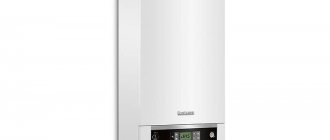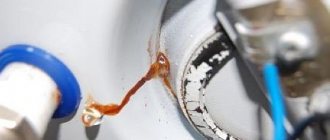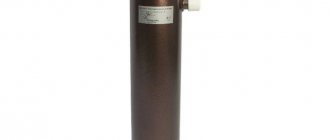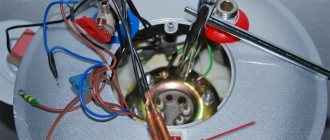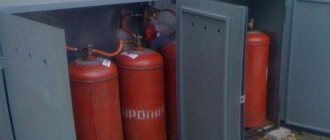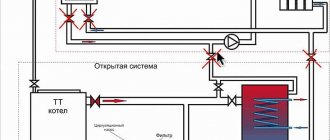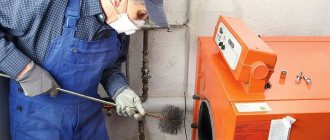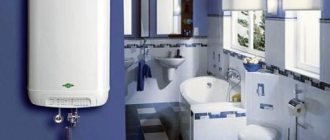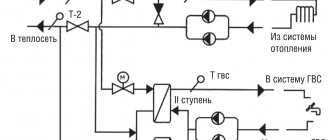A boiler is an indispensable device for homes that are not connected to a centralized hot water supply system. The variety of products on the market makes it difficult for buyers to choose.
The differences lie in appearance, heating method and other technical parameters. Experts recommend paying attention to the volume and power of the water heater.
Calculation formulas
To calculate how much energy a boiler consumes, you should take into account its volume, the time it takes to heat water and the power of heating elements. You can see all this data in your passport, but when choosing on the Internet, there is no such option. Therefore, the easiest way is to calculate the consumption yourself.
To calculate the water heating time, we use the formula: time = 0.00116 * volume (hot water temperature - tap water temperature) / power. From here it is easy to calculate how much electricity will be spent on this by multiplying the operating time by the power of the heating element.
Taking an average family of three, which consumes about 200 liters per day, we calculate the estimated energy consumption per day by dividing 200 by the volume and multiplying by the electricity for one tank. Multiplying the resulting value by 30, we get the number of kilowatts that will be required per month to maintain the hot water supply. The cost of maintaining heat in the standby state can be ignored because it is minimal.
Boiler: what is it and how does it work
A storage type water heater is a large tank of water connected to a mixer. It is filled by turning on the “cold” tap, after which the heating element turns on and heats the water. All you have to do is turn on the “hot” tap and use warm water until the boiler runs out.
The boiler works, in a sense, on the principle of a thermos. You fill it with water, it heats it to a comfortable temperature, and then maintains this temperature until the entire volume of the tank is used up. This wastes electricity. Is it cheaper to pay for electricity than for gas? Let's compare the average costs of maintaining a water heater and a boiler.
Characteristics of boilers with a capacity of 50 liters
Let's take three 50-liter devices with different parameters and calculate their effectiveness. For everyone, let’s assume the temperature of the tap water is 15 degrees, and the hot water is 60 degrees. Daily consumption will be 200 l.
The Ariston ABS VLS EVO PW 50 water heater has two heating elements of 2500 watts. The heating time for a full container is 0.00116*50*(60-15)/2.5 = 0.928 hours, which is about 55 minutes. Daily consumption will be equal to 200/50*0.928*2.5 = 9.28 kW per day. This is 278.4 kW per month.
Boiler Ariston ABS VLS EVO PW 50
Electrolux EWH 50 Centurio DL is equipped with two heating elements of 1 kW each. All water is heated in 0.00116*50*(60-15)/2 = 1.3 hours, which is approximately what is written in the characteristics of the device. Per day this is 200/50*1.3*2 = 10.4 kW, 312 kW per month.
Boiler Electrolux EWH 50 Centurio DL
Ariston ECOFIX 50V 1.2 K is equipped with a 1.2 kW tubular electric heater. Time for heating is 0.00116*50*(60-15)/1.2 = 2.17 hours. 200/50*2.17*1.2 = 10.4 kW will be collected per day, 312.4 kW per month.
Boiler Ariston ECOFIX 50V 1.2 K
Calculation of the consumed amount of hot water per day
The cost, size and power of the boiler depend on this indicator. For a family with one child, at least 25 liters are consumed per day. This indicator includes: washing dishes and hands, hand washing and a light shower. If there are two children in a family, up to 250 liters are consumed per day. This may include: taking a bath, operating the washing machine, as well as wet cleaning. Such calculations are approximate, as they are based on customer reviews. The exact data can be found by installing a meter. The total figure should be divided by the number of days. This will give you the water consumption per day. Therefore, it is possible to determine which boiler is the most economical.
Let's consider an example of calculating the consumption of hot water for three people. On average, a family consumes about 70 liters of water per day. The temperature in the boiler can heat up to 90 degrees, and in the central water supply - up to 60 degrees. Thus, the hot water in the boiler mixes with cold water and produces more warm water than necessary. Therefore, it is recommended to buy a boiler with a volume of 40-50 liters.
Comparison of models with a volume of 80 liters
Let's take the daily norm as 250 liters, which is enough for 4 people.
Ariston 80V 1.2 K for 80 liters with a 1200 W heating element heats the full container in 0.00116 * 80 * (60-15)/1.2 = 3.48 hours. 250/80 * 3.48 * 1 are consumed per day ,2 = 13.05 kW, which will be 391.5 kW per month.
Boiler Ariston 80V 1.2 K
Electrolux EWH 80 Formax DL has two 2000 W heating elements. The entire container heats up in 0.00116*80*(60-15)/2 = 2.088 hours. 250/80 * 2,088 * 2 = 13.05 kW are consumed per day, in 30 days the result is also 391.5 kilowatts.
Boiler Electrolux EWH 80 Formax DL
Gorenje FTG 80 SM with two tubular heaters with a total power of 2600 watts. Water heats up in 0.00116*80*(60-15)/2.6 = 1.6 hours. 250/80*1.6*2.6 = 13 kW are consumed per day, 390 per month.
Boiler Gorenje FTG 80 SM
Boiler power
Boiler heating element
This parameter is considered one of the main ones when choosing an electric heater - the normal operation of the electrical network in the apartment depends on the power, since not every wiring is capable of supporting devices with high voltage. The speed of heating water to the specified temperature also depends on this.
The performance of the boiler is determined by the heating element, which ensures that the device performs its main function. The principle of its operation can be compared to an electric kettle: the more powerful the heating element, the faster the water will reach the set temperature.
The performance of the water heater ranges from 1.5-27 kW and depends on its type. They are:
- flow-through;
- accumulative;
- combined.
The latter type is suitable for houses and apartments with an individual heating system, since during operation of a heating system based on a single-circuit boiler, the water in the combined appliance will be heated without connecting to the electrical network. The rest of the year it works from a wall outlet.
To choose the right boiler, you need to take into account the most frequently used water intake points. So, for washing dishes you need a heating element of 6-8 kW, for a shower - 12-16 kW.
Protochny
Instantaneous boiler
Instantaneous water heaters are distinguished by their compact size and instant heating of water. This is ensured by direct contact of the liquid from the water supply with the heating element.
Such devices are often placed in apartments where there are interruptions in the hot water supply or where there is no hot water supply. To use a warm stream in several places, for example in the shower and in the kitchen, you need to choose a boiler with the appropriate performance.
The power of flow heaters varies from 3 to 27 kW. Boilers with a power of 3-8 kW are capable of heating up to 6 liters of water per minute, which completely covers the needs of a family of 3-4 people.
However, it should be taken into account that in a standard apartment with a single-phase voltage of 220 V it is impossible to install equipment with a power of more than 5 kW - the wiring will not withstand it.
If we are talking about a private house, where the power supply reaches 380 V, then you can purchase more powerful models.
Cumulative
Storage boiler
Storage devices are large in size, as they contain a tank for storing heated liquid. The principle of its operation is as follows:
- The boiler fills the tank, turns on the heating and turns off automatically after reaching the set temperature.
- When you open the tap, hot water flows into the faucet or diffuser in the shower.
- As the container empties, it is refilled with cold liquid and the boiler is turned on again to heat it up.
The main disadvantage of storage water heaters is the long wait for the liquid to heat up. The speed depends on the power of the device and the volume of the tank.
The average boiler, which is suitable for any apartment, consumes from 1.5 to 3 kW. With this performance, 30 liters of water will heat up in 1-1.5 hours, and 120 liters in 4 hours.
Parameters of hundred-liter water heaters
We take a consumption of 300 liters per day, which is suitable for 5-6 living people.
The GBF 100 T/V9 100 liter burner has 1400 W heaters. Heating time 0.00116*100*(60-15)/1.4 = 3.7 hours. It will consume 300/100 * 3.7 * 1.4 = 15 kW per day, in 30 days 466.2 kW.
Boiler Gorenje GBF 100 T/V9
Bosch Tronic 1000 T ES 100-5 2000W BO L1X-NTWVB at 2000 watts will heat water in 0.00116*100*(60-15)/2 = 2.61 hours. 300/100 * 2.61 * 2 = 15.6 kW will be required per day, 469.8 kW per month.
Boiler Bosch Tronic 1000 T ES 100-5 2000W BO L1X-NTWVB
Atlantic O'PRO TURBO VM 100 D400-2-B at 2500 watts will heat all the liquid the fastest - in 0.00116*100*(60-15)/2.5 = 2.088 hours. It will consume 300/100 * 2.088 * 2.5 = 21.6 kW per day, and 648 kW will accumulate in 30 days.
Boiler Atlantic O'PRO TURBO VM 100 D400-2-B
You should also take into account the availability of a night rate. It may be more profitable to heat a lot of water at night and then use it throughout the day. In winter, the temperature of the water supply is much lower, which increases the heating time.
We can conclude that models with different parameters consume approximately the same electricity reading. At the same time, the price of powerful devices can be several times higher, which is explained by practicality - heating is faster.
Is it cheaper or more expensive to use a speaker?
An average geyser with the wick always on consumes 0.6-0.8 m3 of gas. Thus, 22-24 m3 of gas comes out per month, which even at the Moscow tariff for 2022 (5.7 rubles for houses with central heating and a water heater - for example, “Khrushchev”, “gostinok” and “small family”) is only 136.8 rubles.
And this is the consumption with a constantly running column. Meanwhile, in reality, of course, no one keeps it on 24/7. It is either lit with a match immediately before using the water and then extinguished, or turns on and off automatically. So if you really want to save money, buy not a boiler, but an automatic gas water heater - for example, like this one:
A note on water heating efficiency
There is a common misconception that electric water heaters have an efficiency of 100%. This is due to the fact that in theoretical calculations energy losses are often neglected due to their small magnitude. But when calculations have practical application, it is easy to notice that in reality, energy losses when heating water occur from the first seconds. Depending on the heating device, these may be the following types of losses:
- to warm up the heating element itself (electric stove),
- to heat the walls of the container (kettle, tank),
- losses due to vaporization during boiling,
- heat transfer and thermal radiation of energy into the environment (from the walls of the vessel and/or heating element),
- evaporation from the surface of water in open containers (kettles and pans without lids),
- losses in electrical wires and contacts (heating of the wires and plug of the electrical appliance).
Additional minor losses include:
- losses due to side electrochemical processes (ionic heaters),
- sound losses (noise produced by steam bubbles at the point of contact of the heater or hot surface with water).
Based on the directions of losses, it is not difficult to determine measures to increase the efficiency of the water heating process:
- use of an immersion heating element,
- using a closed container,
- thermal insulation of the container,
- using the minimum required heating temperature.
How to save on a water heater: how many kW does a water heater consume per month
In the matter of saving electricity, one cannot do without making calculations and drawing up an approximate schedule of daily consumption. For storage systems, the following is taken into account:
- Heating tank volume;
- Passport data of the power consumption of the heating element;
- Heating time to the set temperature;
- The temperature of the supplied water from the water supply system.
For modern boiler models, electricity consumption is indicated in the passport data
For modern boiler models, electricity consumption, depending on the set heating temperature, is indicated in the device data sheet, while manufacturers take into account the maximum daily hot water consumption.
To calculate the total energy consumed by flow devices, the following is taken into account:
- Device performance;
- Operating time in a daily cycle;
- Temperature of heated water;
- Cold water supply temperature.
It is worth noting that modern models with intelligent control systems are not only more economical compared to models 5-7 years ago, but also make it possible to maximally meet all household needs for hot water, depending on the consumption cycle. This applies equally to boilers with heating tanks and instantaneous heating devices.
A properly organized daily cycle of hot water consumption and setting the correct settings for the heating element will help you save the maximum amount of kilowatts of electricity. The list of factors that reduce energy consumption should include:
- Saving mode for everyday use - it is reasonable to inculcate the habit of washing your hands with cold water, doing morning toilet activities such as shaving not with the jet on, but using a cup or ladle;
- Wash dishes immediately after eating, when food residues are easily washed off, but if this is not possible, then first soak the dishes in cold water;
- Washing vegetables should be done in a saucepan, having first filled it with water, and do not simply flush the water down the drain;
- For boiling, use a small volume of water needed for one or two servings of tea or coffee; do not fill the kettle to brew one cup;
- For daily water procedures, it is recommended to use a shower, which will take 30-40 liters, rather than a full bath with 140-150.
It is recommended to use an instantaneous water heater for domestic needs (washing dishes, for example) to reduce electricity consumption
But as regards specifically regulating the performance characteristics of boilers and heaters, the following measures are recommended:
- Set the maximum temperature in the tank at 35-40 degrees;
- For a flow-through heater when cooking and washing dishes, heating up to 40 degrees is sufficient;
- To take a shower or fill a bath, a temperature of 45-50 degrees is sufficient;
- Set a daily timer for the storage device with the heating function turned off at night;
It is not difficult to determine how much electricity a boiler consumes per month; it is enough to carry out simple calculations using the following indicators as a basis:
- Electric heater power according to the technical specifications of the instructions - W;
- Maximum tank volume - V;
- The temperature of heated water to a maximum of 60 degrees - T2;
- Temperature of the supplied water for heating from the water supply T1;
The calculation is carried out using the formula: T=0.00116 * V (T2 –T1) / W.
First, the heating time of the full volume of the tank is determined, and then the total energy consumption of the device.
To heat a volume of 50 liters from 15 to 60 degrees with a boiler with a 1.5 kW heating element you will need:
0.00116 * 50 (60 – 15) / 1.5 = 1.74 hours or 104 minutes
To find out the amount of electricity consumed, multiply the power of the device by the heating time:
1.74 x 1.5= 2.61 kW.
This is interesting: Is it necessary to install a pole to connect electricity on the site - let’s find out in detail
Electricity consumption
Electricity quantity
How many kilowatts does the boiler consume per month? This should be known to those who have already installed a heater or are just planning to do so.
Electricity consumption for heating water depends on many factors:
- Temperature of cold water entering the heater.
- Heat loss from the water heater.
- Water consumption per day.
- Temperature indicator of hot water at the outlet.
The average temperature of cold water before entering the water heater ranges from five to ten degrees. The average heat loss of a boiler is in the range of 0.007 - 0.0011 kW per liter of water. To find out how much water will be consumed per day, you need to divide the hot water consumption by the number of days in a month.
Despite the desire to save, experts do not recommend heating the water in the boiler below fifty-five degrees. There is often a repulsive odor. This is due to the fact that pathogenic microflora may begin to develop in the liquid, which will negatively affect health.
Storage water heater
In standby mode, the water heater also consumes electricity; it is aimed at compensating for heat loss. The technical data sheet for each boiler model indicates the amount of heat loss. They can be indicated in percentages or kilowatts.
Read
How much electricity does the heater consume?
Let's try to calculate the approximate electricity consumption of the boiler. For example, equipment heat loss is half a percent per hour. Let’s imagine that a family needs two hundred liters of water. The cold water temperature at the inlet is ten degrees, and at the outlet - fifty-five.
To find out how many kW the boiler consumes, you should make simple calculations. It is generally accepted that 1.16 W is required to heat water by one degree. The formula for calculating electricity consumption is simple: you need to multiply 0.0016 kilowatts by the amount of hot water per day and multiply by the difference between the water at the outlet and the cold water at the inlet. The resulting indicators are the number of kilowatts required to heat the water.
Using our example, we get the following result - 14.4 kW. This is the number of kilowatts consumed per day. To calculate resource consumption per month, gently multiply the amount spent in one day by thirty. That's four hundred and thirty-two kilowatts per month. Calculation taking into account heat loss equal to 0.5 will give the following result: kilowatt consumption per day is 16, 13 kW. Multiplying the number by the number of days in a month, we get the final result.
Now let's try to calculate how much a flow-through heater consumes.
Flow-through heaters are connected directly to the mixer and do not depend on the water pressure in the central pipeline. It is worth noting that the output water does not always satisfy demands. The documentation for the heater most often indicates the temperature, which must be summed with the input indicators. Consumption depends on the frequency and intensity of use of the heater. With moderate use, consumption does not exceed one hundred kilowatts per month.
Let's sum it up
To calculate the electricity consumption of a storage water heater, it is important to obtain the following information:
- Find out how much water is used daily.
- Find out how much electricity the device consumes per hour of operation.
- Make mathematical calculations by multiplying the results by the number of days in a month.
It should be remembered that electricity consumption may vary significantly between different devices. The amount of energy consumption will be affected by the frequency and intensity of use of heating equipment.
It is possible and necessary to reduce the size of electricity bills.
Flow heater.
There are a number of recommendations that help adjust expenses.
- Find out how long the boiler takes to cool down. Provided that you are away from home for this period of time or longer, it is advisable to drain the water and turn off the device.
- Check the thermal insulation of the device body. If the top of the water heater is warm, it has errors in insulation. Additional thermal insulation should be installed.
- Installing an indirect heater will help you save a lot on electricity bills. The water will be heated from the heating system and enter the boiler already warm.
- If your water heater has a timer and controller, program it to turn on for a certain time before you return and turn it off when you are away.
- Monitor the condition of the heating element. If it has a deposit of scale, the efficiency of the device decreases and energy consumption increases significantly.
Read
How much electricity does the printer consume?
Is a tankless water heater profitable?
Instantaneous water heaters are most often used to heat water in country houses. Such equipment is easy to install yourself. The main disadvantage of instantaneous water heaters is their short service life - 5 years.
The water heats up as water enters. The power of the device does not depend on water pressure. Typically, a water heater provides warm water that you can use to wash dishes or take an outdoor shower. Due to some features, such a device is not suitable for taking a bath. It is recommended to install an electrical plug, socket and separate electrical cable. This is necessary in order not to reboot the main network.
A instantaneous water heater can have a power of 3-27 kW. For two people, a 10 kW device is suitable. For a large family, it is better to choose a water heater with a capacity of 20 to 25 kW.
Before purchasing, you should read the instructions, since some water heaters require a voltage of 380 V. If you nevertheless decide to connect the device to a 220 V network, then the electrical plugs in the meter will be knocked out.
The instantaneous water heater must be grounded, as it is installed on a metal mixer.


